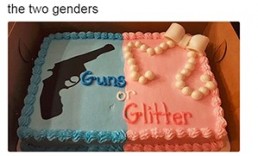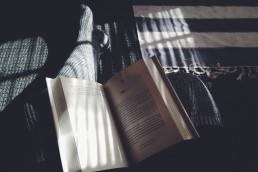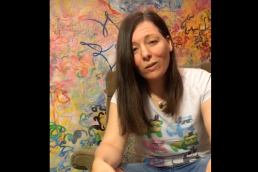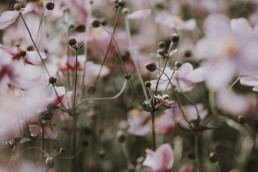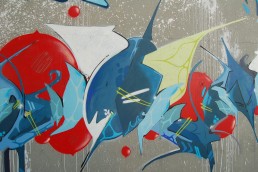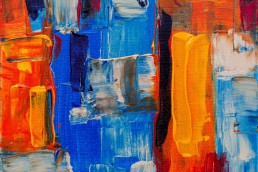by Robert O'Sullivan
You know an idea or concept has entered the mainstream consciousness when it’s become a meme. Forget data, years of research, or having a place on the curriculum, memetic quality is what truly counts when you want a subject to really have an impact in the general zeitgeist. I didn’t do biology in school, but because of memes even I know that mitochondria are the powerhouse of the cell…I’m not totally sure what that means, or what a mitochondria actually is, besides being the powerhouse of the cell, of course. One of the more frequent memes I’ve seen for years, and really haven’t stopped seeing, is the ‘two genders’ meme.
The meme can be positive or negative (though usually negative), with the positive mostly being trans people poking light-hearted fun at gender, while the negative generally tends to paint gender identities that aren’t male or female as being ‘fake’ or ‘made up on Tumblr’. That dynamic – the two ‘main’ genders of male and female – is also known as the gender binary. Both positive and negative sides of this meme do enforce at least the idea that people out there identify as something other than male or female – something outside the gender binary.
Identities outside that male-female binary have existed for centuries all around the world, primarily in ‘native’ cultures in America, Africa, Polynesia and Asia. Though colonial powers of the time tried their best to stamp these identities out, some have survived and thrived in the modern day, with identities like the Native American ‘two-spirit’ gaining popularity outside of their traditional communities. So, to those who believe that ‘there are only two genders’ or that identities like genderqueer or genderfluid were ‘invented by Tumblr’: non-binary and non gendered people have always existed, but the advent of the internet, and the ability to communicate with different people from vastly different backgrounds all around the world, finally gave those people the words and terms to adequately describe their lives. Being born in a formerly colonised part of the western world, I grew up only knowing the gender binary we accept as standard – it wasn’t until I got to university age and met other queer people, other people who felt the same way I did, that I first learned of words like non-binary or genderqueer.
Stereotyping and expectations on gender presentation are things that affect people of all genders – men, traditionally speaking, can’t put on makeup or wear skirts, and women are supposed to have long hair or long nails. When binary trans people transition you tend to see them usually play to these stereotypes, both because that’s what they’ve always been told a man or a woman was, and because society expects it of them – surely you couldn’t really be a woman if you have a beard? Gender expression isn’t the same as identity, but sometimes binary trans people have to sacrifice their idea of self for societal expectations and acceptance.
The same can be said for non-binary people – the term ‘non-binary’ isn’t a synonym for ‘androgynous’, but you’re more than likely lying to yourself if you don’t think non-binary people are supposed to look like Tilda Swinton or David Bowie. While it’s okay for trans people to want to meet these societal expectations, it’s not okay to withhold your belief in their identity on their meeting of those standards.
Despite non-binary identities being around for centuries, it’s hard to shake off the perception that non-binary people must be androgynous. And a specific type of androgyny at that – a thin, typically white form of androgyny, one that’s generally feminine with a masculine edge. Not only is this idea of non-binary identities not true to the wider historical context – a lot of the traditional non-binary identities come from traditionally non-white communities – it’s also simply an unattainable standard for a lot of people. A substantial amount of trans people (not all) already go through dysphoria because of their assigned gender conflicting with their gender identity, and tying concerns about things like body weight directly in with the concept of ‘passing’ just serves to double down on the gatekeeping of trans happiness.
Happiness is, ultimately, what we all strive for at the end of the day, but it’s something that studies show is frequently out of reach for trans people. A 2012 study conducted by TENI (Transgender Equality Network Ireland) found that 78% of trans people around Ireland and the UK had considered taking their own lives, with 40% of respondents saying that they had attempted suicide at least once in their lives. This was reflected by a survey of young trans people conducted by UK charity said that 92% of respondents had considered taking their own life. Feeling like they have an unachievable standard to meet to be seen as valid (or just to avoid harassment) feeds into the negative mental health of trans people. Self-image is something a lot of people struggle with, but not having ownership over that central part to one’s own identity is a crushing prospect that trans people have to live with.
I really want to repeat some statistics here, because I feel like just dropping them in the middle of a paragraph doesn’t drive home the gravity of the numbers: 78% of all trans people in the UK and Ireland, binary and not, had considered taking their own lives at least once…40% even made an attempt! Really try to picture 100 people in your mind, then take three quarters of them away; take just under a half. That’s the reality for trans people today. That’s the reality for trans people like me today.
I am one of that 78%. I am one of that 40%. I took that survey in 2012 at age 18, struggling to come to terms with my identity. I knew I wasn’t totally a man, and I knew I wasn’t a woman — nothing fit me; I felt like an outcast. The only kind of guidance I thought I had for something other was celebrities like David Bowie. Well for one, David Bowie was a cisgender man, not trans, and secondly, as much as I dug Ziggy’s style, it just wasn’t going to work for a bulky 250+ pound beardy fucker from ‘little catholic Ireland’. It took me a long long time to accept that not every non-binary queer has to look like Aladdin Sane, and that I can wear my wrestling t-shirts, and keep my beard, and still be valid; still be real.
We live in a binary society, one that’s slowly being changed, challenged and turned upside-down by young people wearing whatever the fuck they want, by accountants in their 50s quietly changing their pronouns on Facebook to they/them, and by tacky writers wearing their wrestling shirts, keeping their beards and being true to their non-binary selves.
Robert O'Sullivan
Robert O’ Sullivan is an Irish journalist and former editor of The UCC Express newspaper.
Ida Henrich
Ida Henrich is a German Cartoonist, Illustrator and Designer based in Scotland. She has worked with award winning publishers, online coaches and magazines. Ida is a graduate of Communication Design at the Glasgow School of Art where she specialised in Illustration. In her own work she explores themes such as sex-education, growing up, and women’s experiences. Her comics and illustrations are written for both men and women and aim to start an open dialogue between partners, friends, parents, and children about their experiences. Ida believes that Art is a powerful way to make ideas and feelings tangible.
As Art Editor at Fearless Femme, Ida is responsible for all things visual, including the correspondence with our visual artists, the design and realisation of the online magazine and the illustration of our amazing cover women. She also creates artwork for some of our articles, poems and stories.
Ida loves her coffee in the morning, that feeling after finishing an illustration and going for a run in the (Scottish) sun; and pilates on the rainy days. Ida enjoys SciFi books and autobiographies, and autobiographical comics. She is always delighted to meet new people on trains but is also smitten being home alone colouring in an illustration that she has made way too intricate while listening to Woman’s Hour. You can contact her at ida@fearlessly.co.uk.

